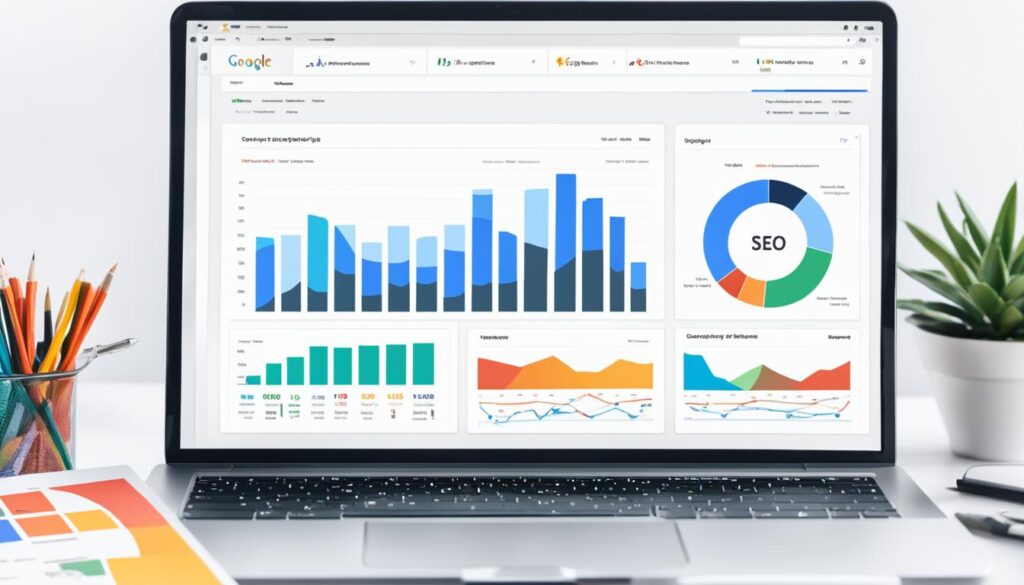Blog
How to setup SEO optimization for Search Engines: A Step-by-Step Guide
Welcome to our comprehensive guide on SEO optimization. If you’re looking to improve your website ranking and attract organic traffic, you’ve come to the right place. In this guide, we’ll take you through the process of optimizing your website for search engines.
Firstly, let’s understand what SEO optimization is. In simple terms, SEO or search engine optimization is the process of optimizing your website to rank higher on search engine results pages (SERPs) for relevant organic keywords. A higher ranking on SERPs means more visibility, increased traffic, and greater chances of conversion.
Organic traffic refers to visitors who land on your website through search engine results rather than paid ads. By optimizing your website for search engines, you can attract targeted organic traffic, leading to better engagement, more conversions, and higher revenue.
Key Takeaways:
- SEO optimization is crucial for improving website ranking and attracting organic traffic.
- Organic traffic refers to visitors who land on your website through search engine results.
- Higher website ranking leads to more visibility, increased traffic, and greater chances of conversion.
Understanding the Basics of SEO Optimization
Search engine optimization (SEO) is the process of improving your website’s visibility to search engines and increasing organic traffic. To achieve this, it’s essential to understand the basics of SEO optimization.
SEO impacts website ranking by analyzing various factors such as content relevance, loading speed, and user experience. The higher your website ranks, the more visible it becomes to potential visitors, which can lead to increased organic traffic. Thus, the importance of website ranking and organic traffic for your online success cannot be overstated.
Effective SEO optimization involves a combination of both on-page and off-page techniques. In the following sections, we will introduce you to the strategies and tools you need to improve your SEO performance, attract organic traffic, and enhance your website’s online presence.
Conducting Keyword Research for SEO
Conducting keyword research is an essential part of SEO optimization. The right keywords can help improve your website’s visibility and increase organic traffic. In this section, we’ll guide you through the process of selecting the most relevant keywords for your website.
Understanding Your Audience
The first step in conducting keyword research is understanding your audience. Who are they and what are they searching for? What are their pain points, and how can your website help solve them?
Creating buyer personas can help you understand your audience better. Once you’ve created your personas, you can use keyword research tools to find the keywords they’re searching for.
Keyword Research Tools
There are several keyword research tools available that can help you find the most relevant keywords for your website, including:
| Tool | Description |
|---|---|
| Google Keyword Planner | A free tool that allows you to find keywords related to your business or industry. |
| SEMrush | A comprehensive SEO tool that includes keyword research and analysis. |
| Ahrefs | A tool that allows you to analyze your competitors’ keywords and find new keyword opportunities. |
It’s essential to choose the right keywords for your website. Look for keywords with a high search volume and low competition.
When selecting keywords, use long-tail keywords that are specific to your business or niche. For example, instead of using “dog food” as a keyword, try “organic dog food for senior dogs.”
Once you’ve chosen your keywords, incorporate them into your website’s content, including your page titles, meta descriptions, headers, and body copy. This will help search engines understand the context of your website and improve your website’s visibility.

By conducting thorough keyword research and incorporating relevant keywords into your website’s content, you can improve your website’s visibility and attract organic traffic.
On-Page SEO Optimization Techniques
On-page SEO optimization is a vital part of the website optimization process. By primarily focusing on your website’s content and structure, you can improve the website’s visibility on search engines and influence the ranking. The following SEO techniques will help you optimize your website’s on-page factors effectively:
- Optimizing Meta Tags: Meta tags are non-visible, descriptive HTML tags that provide information to search engines. Properly optimized meta tags, including the title tag and meta description, can significantly impact your website’s ranking.
- Creating High-Quality Content: Your website’s content is a crucial factor in determining your website’s ranking. Ensure high-quality, informative, and engaging content, providing value to readers.
- Improving Website Loading Speed: A sluggish website can lead to a high bounce rate, negatively affecting your website’s ranking. Optimize your website’s loading speed, enabling faster page load times.
By incorporating these on-page SEO techniques, you can maximize your website’s potential to rank high on search engines, driving organic traffic to your site.
Off-Page SEO Optimization Strategies
While on-page SEO optimization techniques focus on improving your website’s content and structure, off-page SEO strategies involve external factors that enhance your website’s search engine rankings. These strategies are crucial for boosting your website’s domain authority and credibility. Here are some off-page SEO optimization techniques:
- Building high-quality backlinks: Backlinks are links from other web pages that point to your website. High-quality backlinks from authoritative websites can significantly impact your website’s SEO performance and rankings.
- Social media promotion: Promoting your website’s content and pages on social media platforms can drive traffic to your site and increase its exposure. Ensure that your social media channels are optimized and regularly updated to maximize your results.
- Online reputation management: Online reputation management involves establishing and maintaining your brand’s reputation on the internet. This includes managing customer sentiment, monitoring mentions of your brand online, and addressing negative feedback.
Implementing these off-page SEO optimization techniques can significantly impact your website’s search engine rankings and improve its overall performance. By increasing your website’s domain authority and credibility, you can attract more organic traffic and boost your online success.
Analyzing SEO Performance with Tools
After optimizing your website, the next step is to monitor and analyze your SEO performance. This will help you identify areas for improvement and adjust your strategy accordingly. Luckily, there are several SEO analysis tools available to help you with this task.
SEO audit tools: These tools analyze your website’s overall SEO performance, identifying technical issues that may impact your rankings. They evaluate key factors, such as website speed, mobile optimization, and website architecture. Examples of SEO audit tools are SEMrush, Ahrefs, and Moz Pro.
Keyword research tools: Keyword research is an essential element of SEO optimization. These tools help you identify the best keywords for your content and analyze your competitors’ keywords. By using keyword research tools, you can determine the search volume, difficulty level, and competition for each keyword. Examples of keyword research tools are Google Keyword Planner, Ahrefs, and SEMrush.
Ranking monitoring tools: Monitoring your keyword rankings is crucial to tracking your SEO progress. With these tools, you can track your performance in search engines and monitor your website’s rankings for specific keywords. This will help you determine the effectiveness of your SEO efforts and make data-driven decisions. Examples of ranking monitoring tools are SEMrush, Ahrefs, and Google Search Console.
Web analytics tools: These tools help you analyze your traffic and audience, providing insights into user behavior and engagement. By tracking your website’s traffic, you can identify trends, monitor conversion rates, and determine the effectiveness of your content. Examples of web analytics tools are Google Analytics, SEMrush, and Ahrefs.
By utilizing these SEO analysis tools, you can gain valuable insights into your website’s performance and make data-driven decisions to improve your SEO.

Best Practices for Content Optimization
Effective content optimization is a key component of improving website rankings and attracting organic traffic. By following these best practices for creating SEO-friendly content, you can ensure your website stands out among the competition:
- Optimize headlines and subheadings with relevant keywords to improve readability and align content with search queries
- Create high-quality, informative content that is written for your target audience
- Incorporate multimedia elements such as images and videos to enhance engagement
- Improve readability by breaking up long paragraphs and using bullet points and lists
- Use emphasis tags to draw attention to important information and
blockquotes
to highlight key points or quotes from external sources
By implementing these strategies, you can create content that not only performs well in search engine rankings but also engages and informs your audience, driving traffic and building your online presence.

Maximizing Website Optimization Potential
So far, we have explained the fundamental techniques and strategies to optimize your website for search engines. To take your website’s performance to the next level, it’s essential to implement a holistic approach that includes additional optimization strategies and techniques.
One crucial aspect of website optimization is mobile optimization. With the increasing use of mobile devices for browsing the internet, it’s vital to ensure your website is mobile-friendly. This includes designing a responsive website, optimizing images for faster loading, and utilizing mobile-specific features, such as click-to-call buttons and mobile-optimized forms. By doing so, you can enhance the user experience and attract more organic traffic to your site.
Another crucial factor in website optimization is user experience (UX). UX factors, such as website speed, navigation, and design, impact how users interact with your website. By improving these factors, you can decrease bounce rates, increase user engagement, and improve website rankings. Additionally, implementing structured data markup can provide more detailed information to search engines about your website content, resulting in improved visibility and higher click-through rates.
Overall, to maximize your website optimization potential, focus on implementing a holistic approach that includes mobile optimization, UX improvement, and structured data markup. By doing so, you can establish a strong online presence, attract more organic traffic, and improve your overall SEO performance.

Conclusion
Now that you have learned how to optimize your website for search engines, it’s time to take action and implement the best practices discussed. Remember that SEO optimization is an ongoing process, and it requires constant monitoring and adjustments. By regularly analyzing your website’s SEO performance and making necessary optimizations, you can continue to improve your website ranking and attract organic traffic.
Always prioritize website optimization and SEO best practices to ensure your website stays ahead of the competition. Keep in mind that organic traffic is a crucial factor in achieving online success and increasing brand awareness. With the right SEO strategies and techniques, you can maximize your website’s potential and achieve your business goals.
FAQ
What is SEO optimization?
SEO optimization, also known as search engine optimization, refers to the process of making changes to your website and its content to improve its visibility in search engine results. The goal of SEO optimization is to increase organic traffic to your site and rank higher in search engine rankings.
Why is SEO optimization important?
SEO optimization is important because it helps search engines understand your website’s content and determine its relevance to user queries. By optimizing your website, you can attract more organic traffic, increase your visibility in search engine results, and ultimately drive more targeted traffic to your site.
How does website ranking impact SEO?
Website ranking is a crucial component of SEO. When your website ranks higher in search engine results, it has a greater chance of being seen by users searching for relevant keywords. Higher website rankings can lead to increased organic traffic, more visibility, and improved online visibility and brand reputation.
What is organic traffic?
Organic traffic refers to the visitors who navigate to your website through unpaid, organic search engine results. It is the result of effective SEO optimization and can provide valuable, targeted traffic to your site. Organic traffic is preferable to paid traffic because it tends to be more relevant and has a higher likelihood of converting into customers.
What is keyword research in SEO?
Keyword research is the process of identifying and selecting the most relevant keywords and phrases to target in your website’s content. It involves analyzing search volume, competition, and relevance to determine which keywords will drive the most organic traffic to your site. Keyword research is a critical step in effective SEO optimization.
What are on-page SEO optimization techniques?
On-page SEO optimization techniques are practices you can implement directly on your website to improve its visibility in search engine results. This includes optimizing meta tags, creating high-quality and relevant content, improving website loading speed, using descriptive URLs, and optimizing images and multimedia elements.
What are off-page SEO optimization strategies?
Off-page SEO optimization strategies are external factors that influence your website’s search engine rankings. This includes building high-quality backlinks from reputable sources, promoting your website on social media platforms, guest blogging, and managing your online reputation. Off-page SEO techniques can help increase your website’s authority and improve its visibility in search engine results.
What are SEO analysis tools?
SEO analysis tools are software or online platforms that provide data and insights to evaluate and monitor your website’s SEO performance. These tools can track keyword rankings, analyze website traffic, identify potential issues or errors, and provide recommendations for optimization. Some popular SEO analysis tools include Google Analytics, SEMrush, Moz, and Ahrefs.
What are the best practices for content optimization?
Content optimization involves creating high-quality, SEO-friendly content that engages users and improves website rankings. Best practices include conducting keyword research to identify relevant keywords, optimizing headlines and meta tags, incorporating multimedia elements, improving website loading speed, and making content easily readable and accessible to both users and search engines.
What strategies can I use to maximize website optimization potential?
To maximize website optimization potential, you can implement various strategies and techniques. Some of these include improving mobile optimization, enhancing user experience, implementing structured data markup, optimizing website speed and performance, monitoring and analyzing website data, and staying updated with the latest SEO trends and techniques.



